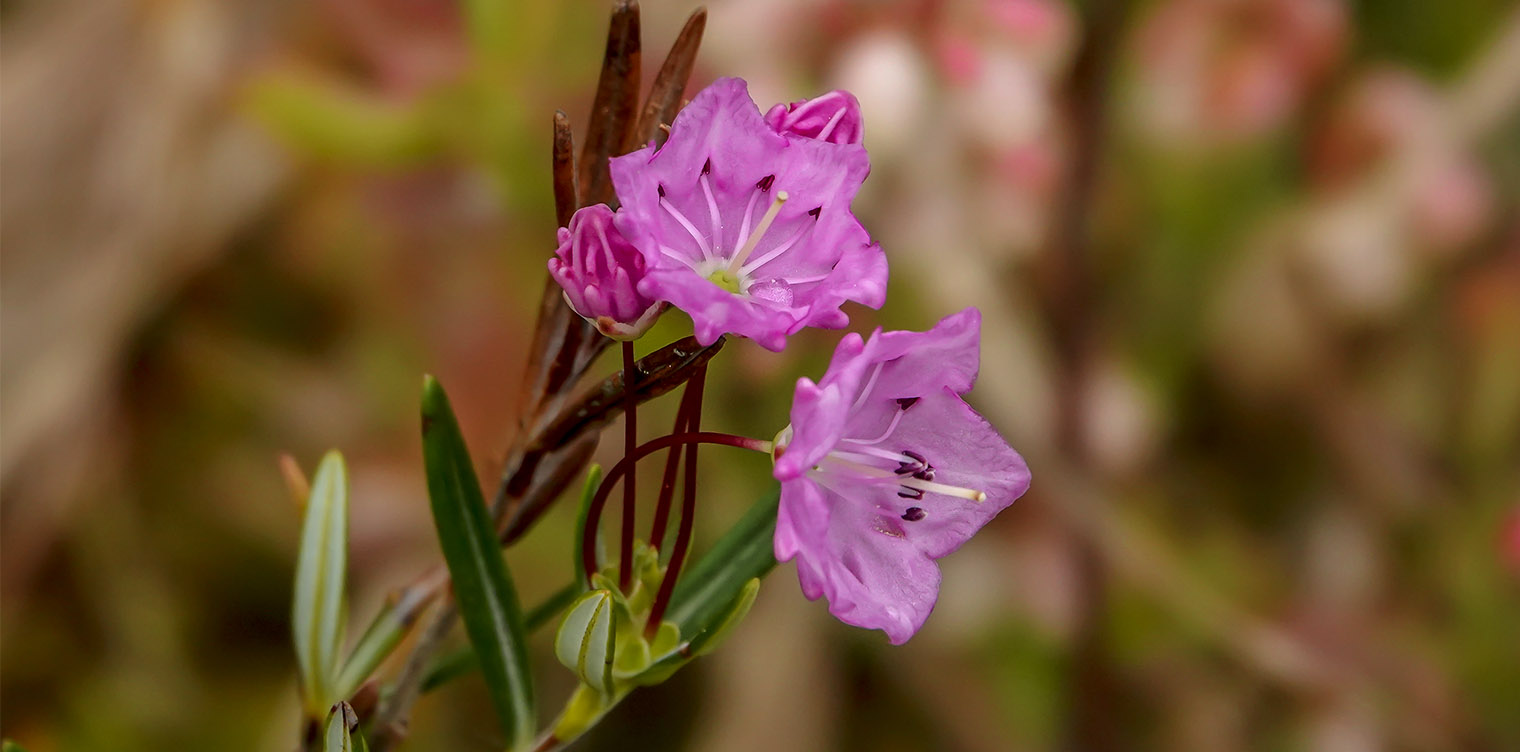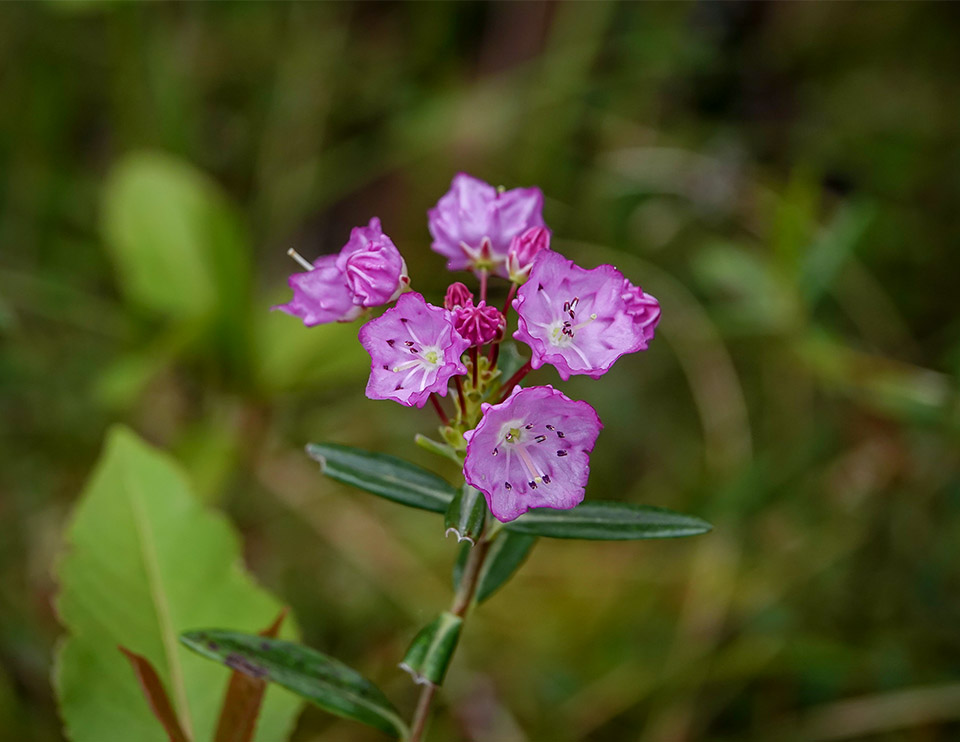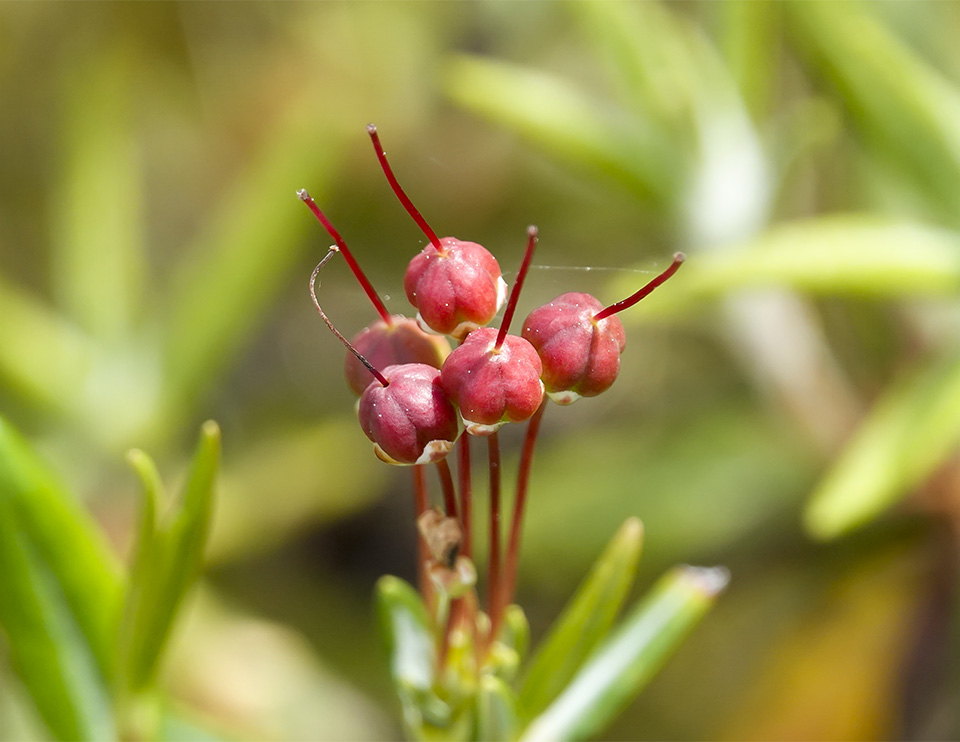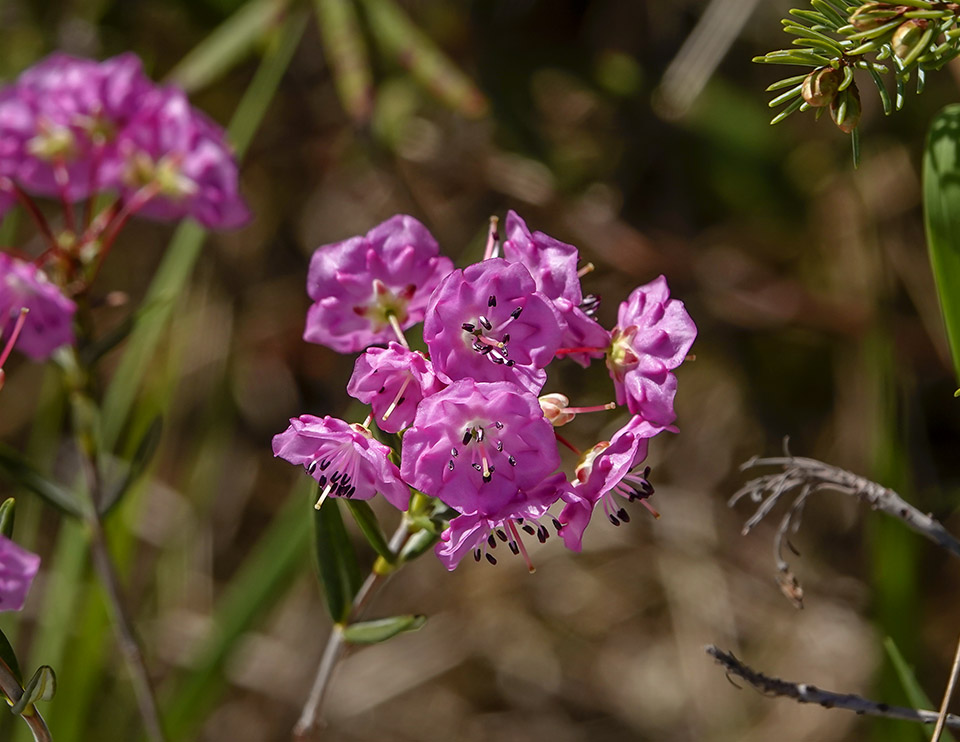Shrubs of the Adirondacks:
Bog Laurel (Kalmia polifolia)

Bog Laurel (Kalmia polifolia) is a low evergreen shrub which flowers in mid-to late spring and grows in bogs in the Adirondack Mountains of upstate New York.
Bog Laurel is a member of the Heath family. It is also called Pale Laurel, Swamp Laurel, and Bog Kalmia. The scientific name is a reference to Peter Kalm, a Swedish botanist who lived in the 18th century and was a student of Linnaeus. Linnaeus reportedly named the genus in a tribute to his student, who was one of the first scientists to examine and study the flora of eastern North America.
Identification of Bog Laurel

Bog Laurel is a small evergreen shrub, six to 22 inches tall. The branches and twigs are two edged. The bark is brown to black.
The leaves are opposite, meaning that two leaves are attached at the same location (a node) on a stem, but opposite one another, on either side of the stem. Bog Laurel's leaves are relatively small (1-1.5 inches long), lance-shaped and leathery, with smooth edges that turn downward. The leaf blade has one main vein running from the base toward the tip. The underside of the leaves has whitish hairs.
There are several competing theories as to why Bog Laurel and certain other members of the Heath Family have adopted these features. One theory suggests that these features reflect a strategy for reducing water loss. Although the bog is frozen in winter, the plant's evergreen leaves are still exposed to the wind, except during periods of deep snow. The small leaf size, the thickness of the leaf, and the rolled-under margins all help minimize water loss. A competing school of thought contends that these features represent an adaptation to nutrient deficiency, not potential water loss. A third theory is that the lower growth forms and tough, leathery leaves of plants like Bog Laurel and Labrador Tea are mainly adaptations to snow and cold. In any event, the leathery, in-rolled leaves provide convenient clues to Bog Laurel's identity.
In spring, the Bog Laurel produces clusters of up to thirteen small, cup-shaped pink flowers. The flowers are 1/3 to 1/2 inch in diameter and are saucer shaped, with five sides. There are ten white stamens, with dark tips, surrounding a pink style in the center. The flowers are pollinated by bees. This plant usually flowers from late May to about mid-June in the Adirondacks. Flowering times for Bog Laurels growing on mountain summits in the High Peaks is a week or so later.

Bog Laurel fruit is a cluster of long-stemmed dry, woody capsules. Each five-chambered round capsule is about a quarter of an inch in diameter, with the remains of the pistil at the top. In the Adirondacks, the fruit generally begins developing in June, maturing by August.
Keys to identifying the Bog Laurel and differentiating it from other leathery-leafed plants growing in swampy or boggy habitats include leaf arrangement, shape, and color, as well as the color and arrangement of the flowers.
- Several features differentiate Bog Laurel from Bog Rosemary. Although both species feature in-rolled leaves, Bog Laurel's opposite leaves contrast with Bog Rosemary's alternate leaves. Also, Bog Rosemary's bell-shaped flowers are very different from the cup-shaped flowers of Bog Laurel. Finally, Bog Rosemary leaves have a blue-gray cast, while Bog Laurel leaves are shiny green.
- Bog Laurel can be distinguished from Sheep Laurel by the placement of its flowers. While the flowers are quite similar, those of the Bog Laurel form clusters at the end of the stem. The flowers of the Sheep Laurel, by contrast, appear a few inches from the top of the stem, with newer leaves above the cluster of flowers. In addition, Sheep Laurel leaves lack the in-rolled edges and white undersides of Bog Laurel leaves. Moreover, Sheep Laurel twigs do not feature two edges.
- Bog Laurel can be distinguished from Leatherleaf, since the latter has alternate leaves. In addition, the leaves of the Leatherleaf are not in-rolled and the undersides have small brown scales. The flowers are also quite different. The white Leatherleaf bells appear on axils of the current year's leaves, forming a one-side raceme, while the pink Bog Laurel flowers appear in clusters at the end of the branch.
- Although the leaves of Labrador Tea also turn downward (like those of Bog Laurel), they are arranged alternately, contrasting with Bog Laurel's opposite leaves. The underside of Labrador Tea leaves are covered with a dense mat of tangled woolly hairs which are white on young leaves and rusty on mature leaves. Finally, the flowers are very different. Labrador Tea has rounded clusters of white flowers, contrasting with Bog Laurel's cup-shaped pink flowers.
Uses of Bog Laurel

Bog Laurel is highly toxic and should not be ingested. Its poisonous foliage and nectar contains toxic resins called grayanotoxins. It may be fatal if eaten.
Given these dangers, this species is rarely, if at all, used in modern herbalism. At one time, some native American groups are said to have used the leaves of the plant as an external treatment for skin ailments. For instance, the Kwakiuti reportedly used a decoction of leaves as a wash for open sores and wounds that would not heal. The Tlingit used an infusion of the whole plant for unspecified skin ailments.
Wildlife Value of Bog Laurel
Bog Laurel has limited importance to wildlife. The food value of this species is limited, since the fruit is dry and minute, and the foliage contains chemicals that are toxic to at least some animals. However, the bog communities where Bog Laurel flourishes are extremely important to some bird species, including the Palm Warbler and Lincoln's Sparrow.
Distribution of Bog Laurel
Bog Laurel is found mainly in the northeastern United States and Canada. Its range includes Labrador to Alaska, south to New Jersey, Pennsylvania, the Great Lakes, and Montana.
Bog Laurel occurs in most New York State counties in the eastern part of the state. It has been reported in all of the counties within in the Adirondack Park Blue Line, with the exception of Saratoga County.
Habitat of Bog Laurel
Bog Laurel can grow in part shade, shade, or sun. In the Adirondacks, you can find this species either in wetlands on lower elevations or on peaty soil on mountain summits in the High Peaks. Bog Laurel is found in several ecological communities in the Adirondack Park, including:
One of the most convenient places to study Bog Laurel is on Barnum Bog, an acidic bog that can be accessed along the Boreal Life Trail boardwalk. Bog Laurel also grows along those sections of the Bloomingdale Bog Trail which traverse the bog.
- Bog Laurel typically grows near small, scrubby specimens of Black Spruce and Tamarack.
- Bog Laurel grows alongside other bog-dwelling evergreen shrubs, including Labrador Tea, Bog Rosemary, Leatherleaf, and Sheep Laurel.
- Wildflowers that flourish in this habitat include Cottongrass, Pitcher Plant, Grass Pink, Rose Pogonia, Buckbean, Roundleaf Sundew, and Marsh Cinquefoil, along with sedges and peat moss such as Sphagnum fuscum and Sphagnum magellanicum.
- Birds found in this habitat or in the drier areas on the edge of the bog include the Palm Warbler, Lincoln's Sparrow, Olive-sided Flycatcher, Yellow-rumped Warbler, Common Yellowthroat, Cedar Waxwing, and Yellow-bellied Flycatcher.
You can also find Bog Laurel growing on the summits of Adirondack mountains in the High Peaks region, including Marcy, Algonquin, Wright, Iroquois, Coldin, Haystack, Basin, Saddleback, Gothics, Dix, and Whiteface.
References
Michael Kudish. Adirondack Upland Flora: An Ecological Perspective (Saranac, New York: The Chauncy Press, 1992), pp. 40, 144.
New York Flora Association. New York Flora Atlas. Bog Laurel. Kalmia polifolia Wangenh. Retrieved 4 November 2019.
United States Department of Agriculture. The Plants Database. Bog Laurel. Kalmia polifolia Wangenh. Retrieved 14 March 2017.
Flora of North America. Kalmia polifolia Wangenheim. Retrieved 14 March 2017.
Northern Forest Atlas. Images. Kalmia polifolia. Bog Laurel. Retrieved 13 November 2021.
Jerry Jenkins. Woody Plants of the Northern Forest. A Digital Atlas. (The Northern Forest Atlas Project, April 2020), p. 217. Retrieved 13 November 2021.
Native Plant Trust. Go Botany. Kalmia polifolia. Retrieved 4 November 2019.
New York State. Department of Environmental Conservation. New York Natural Heritage Program. Ecological Communities of New York State. Second Edition (March 2014), pp. 60-61. Retrieved 17 October 2015.
New York Natural Heritage Program. 2021. Online Conservation Guide for Dwarf Shrub Bog. Retrieved 13 November 2021.
New York Natural Heritage Program. 2021. Online Conservation Guide for Inland Poor Fen. Retrieved 13 November 2021.
New York Natural Heritage Program. 2021. Online Conservation Guide for Open Alpine Community. Retrieved 13 November 2021.
New York Natural Heritage Program. 2021. Online Conservation Guide for Patterned Peatland. Retrieved 13 November 2021.
New York Natural Heritage Program. 2021. Online Conservation Guide for Red Maple-Tamarack Peat Swamp. Retrieved 13 November 2021.
New York State. Adirondack Park Agency. Preliminary List of Species Native Within the Adirondack Park Listed Alphabetically by Scientific Name and Sorted by Habit. Volume 1. Updated 10.23.2006, p. 10. Retrieved 26 January 2017.
Connecticut Botanical Society. Bog Laurel. Retrieved 14 March 2017.
University of Wisconsin. Flora of Wisconsin. Kalmia polifolia Wangenh. Retrieved 14 March 2017.
University of Wisconsin. Shrubs of Wisconsin. Bog Laurel. Retrieved 14 March 2017,
Minnesota Wildflowers. Kalmia polifolia (Bog Laurel). Retrieved 14 March 2017.
Lady Bird Johnson Wildflower Center. Kalmia polifolia Wangenh. Retrieved 14 March 2017.
William K. Chapman and Alan E. Bessette. Trees and Shrubs of the Adirondacks: A Field Guide (North Country Books, 1990), p. 97, Plate 25.
George A. Petrides. A Field Guide to Trees and Shrubs (Boston: Houghton Mifflin Company, 1958,1972), pp. 79, 108.
Doug Ladd. North Woods Wildflowers (Falcon Publishing, 2001), p.76.
Lawrence Newcomb. Newcomb's Wildflower Guide (Little Brown and Company, 1977), pp. 292-293.
Meiyin Wu and Dennis Kalma. Wetland Plants of the Adirondacks. Ferns, Woody Plants, and Graminoids (Trafford Publishing, 2010), p. 39.
Ronald B. Davis. Bogs & Fens. A Guide to the Peatland Plants of the Northeastern United States and Adjacent Canada (University Press of New England, 2016), pp. 104-105.
Roger Tory Peterson and Margaret McKenny. A Field Guide to Wildflowers. Northeastern and North-central North America (Houghton Mifflin Company, 1968) pp. 228-229.
Donald D. Cox. A Naturalist's Guide to Wetland Plants. An Ecology for Eastern North America (Syracuse University Press, 2002), pp. 90.
David M. Brandenburg. Field Guide to Wildflowers of North America (New York, NY: Sterling Publishing Company, Inc., 2010), p.218.
John Kricher. A Field Guide to Eastern Forests. North America (Boston: Houghton Mifflin, 1998), p. 67.
George W. D. Symonds. The Shrub Identification Book. The Visual Method for Practical Identification of Shrubs, Including Woody Vines and Ground Covers (Quill, 1963), pp. 276-277.
William Carey Grimm. The Illustrated Book of Wildflowers and Shrubs (Stackpole Books, 1993), pp. pp. 540-541.
Donald W. Stokes. The Natural History of Wild Shrubs and Vines. Eastern and Central North America (Harper & Row, Publishers, 1981), pp. 181-186.
John Eastman. The Book of Swamp and Bog: Trees, Shrubs, and Wildflowers of Eastern Freshwater Wetlands (Stackpole Books, 1995), pp. 102-104.
Plants for a Future. Kalmia polifolia - Wangenh. Retrieved 14 March 2017.
University of Michigan. Native American Ethnobotany. A Database of Foods, Drugs, Dyes and Fibers of Native American Peoples, Derived from Plants. Kalmia polifolia Wangenh. Bog Laurel. Retrieved 14 March 2017.
Nancy G. Slack and Allison W. Bell. Adirondack Alpine Summits: An Ecological Field Guide (Adirondack Mountain Club, Inc., 2006), p. 61.
Allen J. Combes. Dictionary of Plant Names (Timber Press, 1994), p. 99.
Charles H. Peck. Plants of North Elba. (Bulletin of the New York State Museum, Volume 6, Number 28, June 1899), p. 113. Retrieved 22 February 2017.
